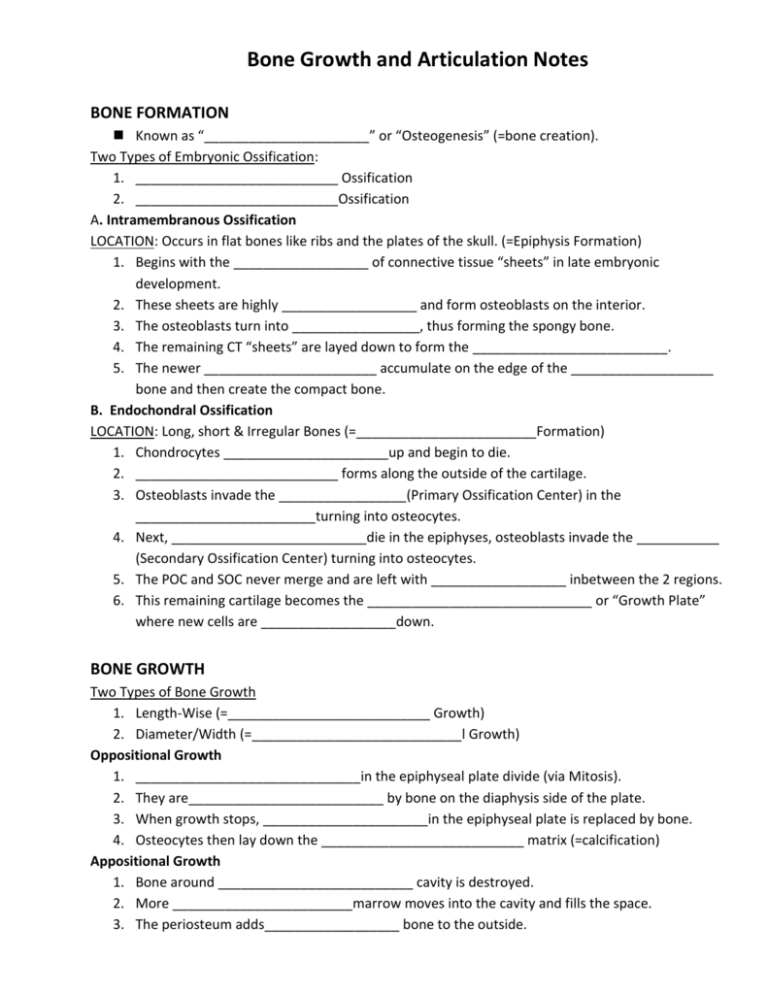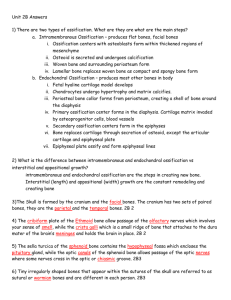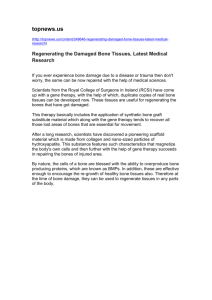Student Notes (Word)
advertisement

Bone Growth and Articulation Notes BONE FORMATION Known as “______________________” or “Osteogenesis” (=bone creation). Two Types of Embryonic Ossification: 1. ___________________________ Ossification 2. ___________________________Ossification A. Intramembranous Ossification LOCATION: Occurs in flat bones like ribs and the plates of the skull. (=Epiphysis Formation) 1. Begins with the __________________ of connective tissue “sheets” in late embryonic development. 2. These sheets are highly __________________ and form osteoblasts on the interior. 3. The osteoblasts turn into _________________, thus forming the spongy bone. 4. The remaining CT “sheets” are layed down to form the __________________________. 5. The newer _______________________ accumulate on the edge of the ___________________ bone and then create the compact bone. B. Endochondral Ossification LOCATION: Long, short & Irregular Bones (=________________________Formation) 1. Chondrocytes ______________________up and begin to die. 2. ___________________________ forms along the outside of the cartilage. 3. Osteoblasts invade the _________________(Primary Ossification Center) in the ________________________turning into osteocytes. 4. Next, __________________________die in the epiphyses, osteoblasts invade the ___________ (Secondary Ossification Center) turning into osteocytes. 5. The POC and SOC never merge and are left with __________________ inbetween the 2 regions. 6. This remaining cartilage becomes the ______________________________ or “Growth Plate” where new cells are __________________down. BONE GROWTH Two Types of Bone Growth 1. Length-Wise (=___________________________ Growth) 2. Diameter/Width (=____________________________l Growth) Oppositional Growth 1. ______________________________in the epiphyseal plate divide (via Mitosis). 2. They are__________________________ by bone on the diaphysis side of the plate. 3. When growth stops, ______________________in the epiphyseal plate is replaced by bone. 4. Osteocytes then lay down the ___________________________ matrix (=calcification) Appositional Growth 1. Bone around __________________________ cavity is destroyed. 2. More ________________________marrow moves into the cavity and fills the space. 3. The periosteum adds__________________ bone to the outside. JOINT TYPES 4 Main Categories of Joints 1. __________________________ 3. ___________________________ 2. __________________________ 4. ___________________________ 1. Immovable Joints _______ movement Example: The plates of the skull that form the cranial sutures. 2. Fibrous Joints __________________ movement in the joint. Dense connective tissue __________________ bones together. Forms _________________________ membrane. Examples: Ulna/Radius and Tibia/Fibula 3. Cartilaginous Joint Formed by _____________________ or Fibrocartilage. Examples: Intervertebral disks (Vertebra),Costal Cartilage (Ribs), Symphysis Pubis (Pubic Bone) 4. Synovial Joints The most “_______________________” joints in the body. Membrane secretes _______________________fluid in the joint. Fluid used for _______________________________ of the joint. Fluid is produced by the ____________________ sack. Bone ends have ____________________________(hyaline) cartilage. ***Types of Synovial Joints (write chart underneath notes on ISN-43).*** BONE TERMINOLOGY 1. ______________on Bones 2. _________________ in Bone 3._______________in Bones 1. Bumps on Bones a) Process = ___________________________ (on vertebrae, scapula). b) Condyle = _________________________, smooth projections (on posterior, distal femur) c) Epicondyle = found _____________________ a condyle (on anterior, distal femur). d) Spine/Crest = thorn-like, _________________________ projection (on tibia shaft). e) Tubercle = ___________________________ process (on humerus). f) Tuberosity = large, __________________________ tubercle (on radius shaft). g) Trochanter = large, rough ____________________________ (found on femur). 2. Depressions on Bones ____________________= flat area that articulates (on vertebrae) __________________ = shallow indentation ( on scapula) 3. Holes in Bones Foramen = ______________for blood vessels, nerves, and ligaments (vertebrae, coxa, cranium). Meatus = bony ________________ (opening for ear) Sinus Cavity = ____________________ filled with _____________(on anterior cranium).











